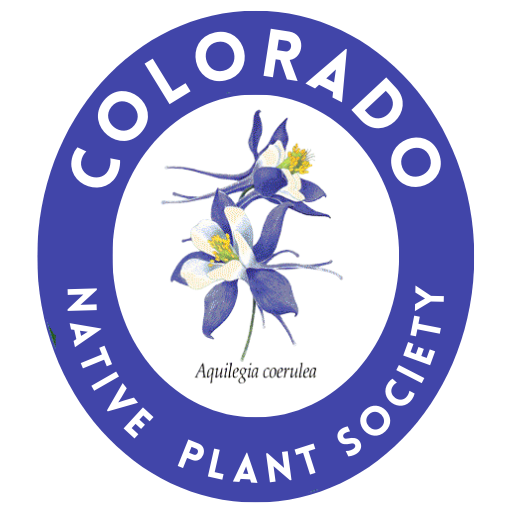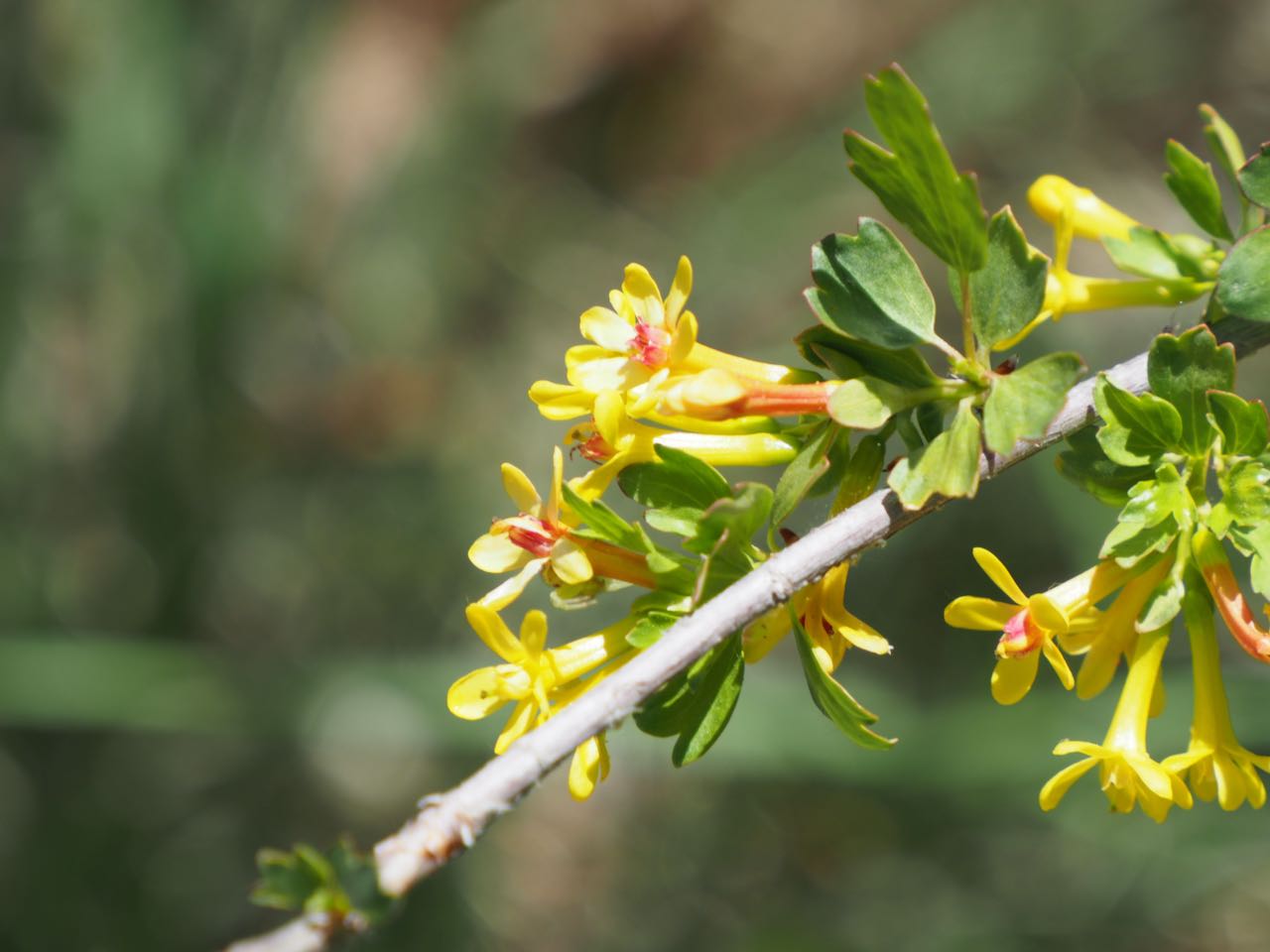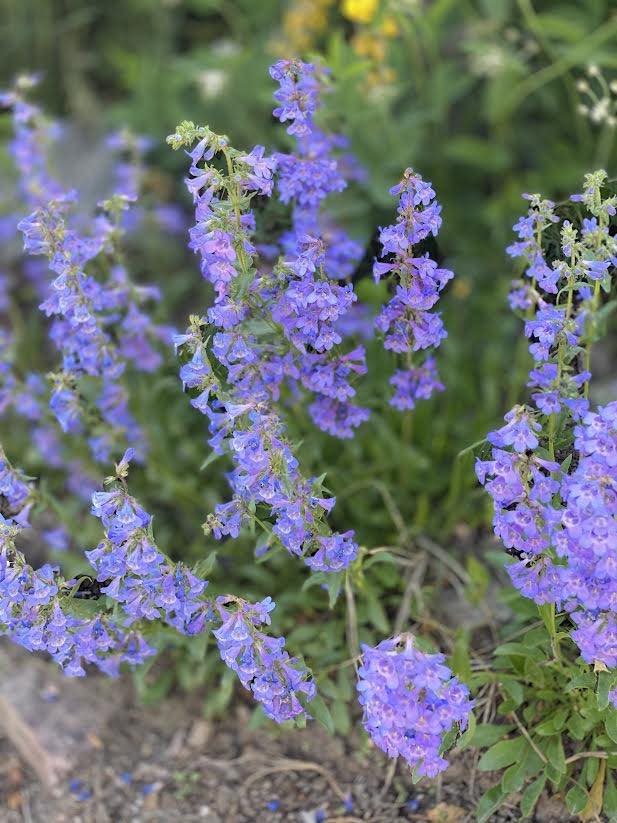I’m the proud owner of a 28-year old native plant garden in central Boulder. I started the
garden myself, back in the 90s, by planting many little shrubs and tiny native pines I got
from a local nursery. Not so surprisingly, over the intervening decades, my little shrubs
and trees got big – and changed what was once a full sun garden into a dry shade
landscape. What’s a gardener to do?
Like I usually do when I need inspiration, I went for a hike in the mountains. And here in
the Front Range, under the dappled shadows of the ponderosa pine trees, I found my
solution: pretty much anything you see growing in the pine forest is by definition a dry
shade plant!
So I want to share some of my favorite Front Range dry shade natives with gardeners
who may be facing a similar dilemma. I’ll break down my list by growth habit, and try to
focus on plants I’ve seen relatively often in the nursery trade, but feel free to add to this
list from your own experience, or modify it if you live outside the Front Range and have
a different palette of species to choose from.
A dry shade garden shown in spring with golden banner blooming.
Shrubs
You’ll see lots of shrubs under the pines! Many provide flowers for pollinators and fruit
for birds. Here are some that have worked out for me as dry shade plants.
Chokecherry (Prunus virginiana) – It blooms early May into early June. Easy to start
from seed, easy to transplant. Runners underground can make it an aggressive problem
when it gets big, but this wonderful bush provides food for birds and pollinators, and the
leaves are a host plant for a number of native insects.
Creeping Holly grape (Mahonia repens) – Yellow fragrant blooms in April and May
provide early nectar for pollinators. It’s low-growing, only about a foot tall, and tough as
nails. It will spread over time! In the late summer it produces edible (but very sour!)
grape-like fruit.
Golden Currant (Ribes aureum) – Another early spring bloomer with yellow tubular
blooms that smell like cloves! This fast-growing shrub will need to be pruned back to
keep it compact. You can eat the little currants if they birds don’t get them first – and
they will spread the seeds around your yard. I have lots of little currant seedlings
coming up to give away. Fortunately it is easy to move and transplant!
Wax Currant (Ribes cereum) – Much like the currant above, but with little pink flowers.
Mountain Mahogany (Cercocarpus montanus) – A large shrub of partial shade, it leafs
out in April. The flowers are tiny little things, but produce seeds with long curly tails late
in the year.
Service Berry (Amelanchier alnifolia) – Although it’s always been slow-growing for me,
this is one of my favorite shrubs! The fruits are delectable and the early spring flowers
provide nectar for insects at a time of year when they really need it. Birds love it, and
help it to reseed itself, giving you lots of little starts to give your friends. I have had good
luck moving the seedlings. More on Serviceberry:
https://conps.org/serviceberry-a-shrub-for-all-seasons/
Skunk Bush, aka Threeleaf Sumac (Rhus trilobata) – Although it’s late to leaf out in May,
it’s very hardy and will grow in partial shade. It may get kind of leggy and need to be
pruned back in the fall. The dry little berries are edible and remind me of dill pickles.
Snowberry (Symphoricarpos albus) – Grows like gangbusters in completely dry shade
to about three feet tall and transplants easily. It can be neglected.
Yucca (Yucca glauca) – Yes, yucca! You’ll see it in dry shade up in the forest. It sprouts
well from seed in early – mid May, seedlings look like thick-bladed grass. But be warned
– if you grow this, you’ll give it blood sacrifice from the sharp spiny leaves. Do not plant it
within six feet of walkways or driveways. The huge spires of pale white flowers make
growing this plant worth it.
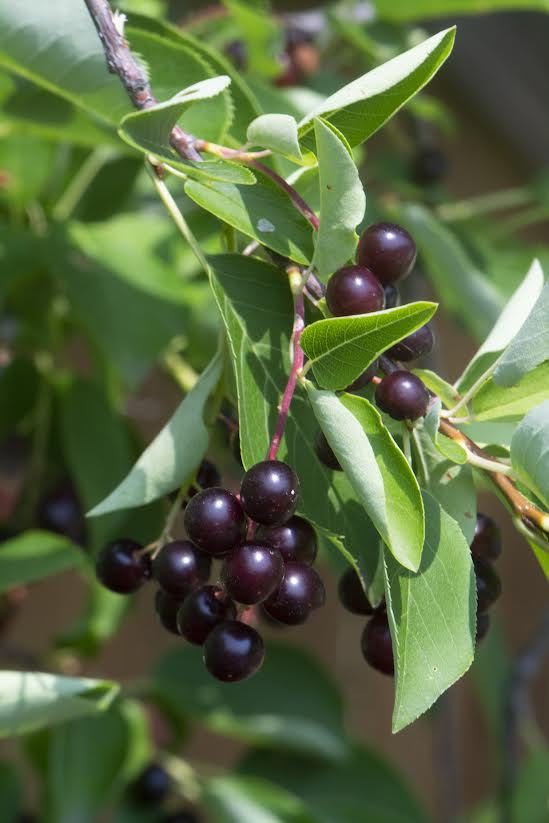
Chokecherry, photo by
Dave Southerland
Golden currant, photo by
Sue Dingwell
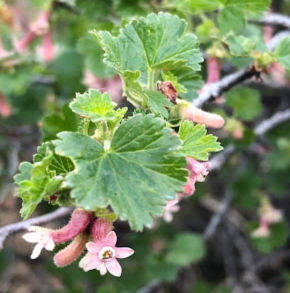
Wax currant, photo by
Carol English
Grasses
Although most native grasses seem to like the full baking sun of the prairie, I’ve had
some luck with a few in dry shade.
Canada Wild Rye (Elymus canadensis) – A common hardy grass from up in the pine forest,
it’s easy to start from seed and transplant. It grow to about three feet tall with gorgeous
seed heads suggestive of wheat or rye. It stays green almost all winter and greens up in
early spring. Grows in clumps.
Green Needlegrass (Nasselia/Stipa viridula) – Another native grass that greens up
pretty early in spring, it will re-seed itself pretty aggressively so be warned.
Little Blue Stem (Schizachyrium scoparium) – Although it is happier in full sun, it will
tolerate partial shade. It looks dead until late spring. I have had good luck growing this
from seed. More on Little blue plus photos:
https://conps.org/big-and-little-bluestems-not-so-blue-in-fall/
Ground Cover
Prairie Sage (Artemisia ludoviciana) – Although a full sun plant of the prairie, it will grow
in partial shade. It’s very transplant hardy. Spreads underground by runners and can
aggressively take over an area!
Silver Sage (Artemisia frigida) – A gorgeous low-growing foliage plant that will be happy
in part shade or sun. You can try it in full dry shade and I think it will grow.
Yarrow (Achillea lanulosa) – A low growing ground cover that’s very transplant hardy. It
stays green all winter. Plants start blooming in early June and bloom through August,
producing foot tall stalks topped by flat white clusters of flowers. It can aggressively try
to take over, both by underground rhizomes and reseeding!
Native Wildflowers
Beebalm/Horsemint/Bergamot (Monarda fistulosa) – One of the best dry shade
natives, the clusters of pale purple flowers attract insects and hummingbirds. It’s easy to start from seed, and sprouts up mid-April, and is easy to transplant. It likes a little extra water: the plants growing under my downspouts get huge and lush. In fall, cut the hollow stems back to about one foot and leave them for native bee nests in the spring.
Curly-cup Gumweed (Grindelia squarrosa) – I see this up in the pine forest. The easy-
to-germinate seeds come up in early May in quantity and look like prickly lettuce so
don’t weed them by mistake! It’s a biennial so it won’t bloom during the first year and the
rosette looks like a nasty thistle-like weed, but in the second year it bolts and blooms
prolifically with beautiful golden flowers in August / September.
Fireweed (Epilobium angustifolium) – A tall hardy native the will do well in partial shade.
Gaillardia / Blanketflower (Gaillardia aristata) – An easy to grow favorite that will
tolerate shade. The first blooms appear in mid to late May and it blooms very well
August through September. More on fireweed:
https://conps.org/fireweed-the-fire-follower/
Golden Banner (Thermopsis divaricarpa) – A big yellow legume that blooms early to
mid May, it will spread over time to create a large patch. I find it impossible to transplant
except as a delicate seedling but once established it is hardy and can be aggressive.
Goldenrod, Tall (Stiff) (Oligoneuron rigida) – A tall native goldenrod that’s easy to start
from seed, and will reseed itself. It blooms in August and September. It’s tough and
grows well in shade, but I find it delicate to transplant and it needs lots of water and care
after moving.
Harebells (Campanula rotundifolia) – A dry shade wildflower, with small purple bell-
shaped flowers. The plant grows to about soccer-ball size. Over several years it will
grow around rocks, creating a lovely effect. Very transplant hardy.
Penstemon, Blue Mist (Penstemon virens) – Sky blue spires of blooms around mid-
May, less than a foot tall. It transplants easily. Under the pines, this penstemon grows in
patches that cover mesa tops with a low blue glow.
Rocky Mountain Columbine (Aquilegia caerulea) – Fairly easy to start from seeds,
which sprout in early April. The plants bloom May and June. I have found that
columbines want a little extra water, so consider growing it under a shady downspout.
Smooth Aster (Aster laevis) – Adult plants can get up to three feet tall and bloom from July
through October. It sows easily, and can take over an area aggressively. Deer browse it,
but that’s actually good (helps it grow bushy and less straggly).
Tall Coneflower (Rudbeckia laciniata var. ampla) – A four to six-foot tall shade lover with
yellow cone flowers, it prefers a little extra water and will do well under downspouts.
You’ll find it wild up in shady moist canyons.
Porter’s Aster (Aster porteri) – A low-growing, shade-loving white aster that blooms in
mid-late August. It’s easy to grow from seed and transplants easily.
White Prairie Aster (Virgulus ericoides or V. falcatus) – A low-growing hardy little white
aster of the prairie, it looks a lot like Porter’s Aster but with short grey-green fuzzy
leaves. It is aggressive, even in partial shade, and starts easily from seed. It spreads by
rhizomes.
Wild Blue Flag Iris (Iris missouriensis) – It blooms mid-May and needs a little extra
water in spring before it blooms (but can dry out afterwards). It will grow happily in dry
partial shade, although it would be happier in a wet sunny place (not much of that in the
Front Range…).
Wild Geranium (Geranium caespitosa) – A low-growing forest plant that greens up in early April, and blooms from early June onwards with pinkish flowers. Impossible to transplant unless it’s very small, but it will re-seed itself amply and fill in a rocky shade garden.
Lots of native plants grow in dry shade! Even if you don’t live in Colorado’s Front
Range, go for an inspirational hike in a wild native forest near you, and see what’s
blooming in the shade under the trees. Then make your own list or add to mine.
Embrace the shade!
MORE INFO and an inspirational photo gallery of his garden can be found on Dave’s website:
www.davesutherland.co/native-plants-daves-home-garden
Dave Sutherland is a community naturalist in Boulder, Colorado. He leads free public
nature walks on many topics, including wildflowers, and tours of his 28-year old native
plant garden.
For more information about Dave’s nature programming, please visit:
www.davesutherland.co/
Blue mist penstemon, photo by
Jan Liverance!
Tall coneflower, photo by
Dave Sutherland
Wild blue flag iris, photo by
Dave Sutherland
